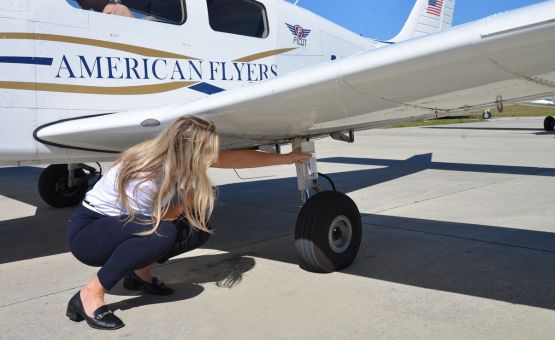In October 2011, an instructor and student were preparing for a flight from a non-towered airport in the southwest. The lesson began as usual, with the instructor guiding the student through the preflight procedures on their aircraft—a Cessna 182. When they reached the nose of the aircraft, the instructor went back into the FBO for about two minutes. During that time, the student completed the remainder of the preflight, including untying the wings from their moorings on the ramp. The student waited for the instructor to return, gave him a thumbs-up upon his arrival, and they both climbed into the plane, started the engine, and prepared to taxi out.
As I conducted the preflight on my Cessna 152 nearby, I heard the engine of the approaching Cessna 182 running at a slightly high RPM, accompanied by a strange scraping noise. I looked over my shoulder and saw the 182 taxiing past, dragging a 40-pound cinderblock attached to its tail hook with a tie-down rope. Both I and the FBO lineman, who quickly drove out in his golf cart to flag down the 182, realized what had happened: the student and instructor had both failed to notice the 182 had still been attached to the cinderblock used to secure the airplane’s tail in its parking space. I watched as the instructor shut down the engine, got out of the plane, and shook his head. He untied the cinderblock from the tail, placed it in the baggage compartment, restarted the engine, and the 182 took off without further incident.
I had only been a certified private pilot for two months at that point and couldn’t believe what I had just witnessed. As I returned to my own preflight, I realized I had completely lost track of where I was on the checklist. The sound of the 182’s engine fading into the distance was soon replaced by the words of my flight instructor echoing in my mind: “Checklist yourself before you wreck yourself.”
Variations on Ice Cube lyrics aside, as pilots, we are “directly responsible for, and… the final authority as to, the operation of that aircraft,” per 14 CFR 91.3. It’s crucial to use checklists for every step of our preflight, in-flight, and post-flight procedures. On my first day learning to fly, my instructor spent an hour walking me through the preflight of the Cessna 152 I would later fly for 48 hours. He explained every step in the checklist—what component we were checking, how to check it, and why it mattered. He also emphasized the importance of being thorough and methodical. If the preflight checklist was ever interrupted, whether by a question, a distraction, or something unusual happening nearby, it was essential to restart from the beginning of the current section. This practice ensured I wouldn’t miss any steps, and it’s a habit I still follow in my preflight checks today.
Forming good habits early in our flying careers is crucial, and they must be reinforced through regular practice. As we become more familiar with the airplanes we fly, it can be tempting to skip or rush through the preflight checklist, similar to how we might with cars. However, the number of steps and different items to check before a flight is far too numerous to rely on memory alone. The mindset of “kick the tires and light the fires” is never appropriate, regardless of how experienced we are. Always follow the checklists provided by the airplane manufacturer and avoid shortcuts or performing steps out of order.
Similarly, we must avoid rushing even if we’re behind schedule before a flight. Essential tasks like weather briefings, weight and balance calculations, performance chart reviews, refueling, and towing all take time and are critical for a safe flight. Once these tasks are completed, it’s important not to hurry through the preflight process. Again, follow the checklists provided by the airplane manufacturer, methodically, logically, and thoroughly.
In 1735, Benjamin Franklin famously said, “An ounce of prevention is worth a pound of cure.” As pilots, our “ounce of prevention” comes from the proper use of checklists. By diligently using our preflight checklist to ensure our aircraft is in safe flying condition, we can identify potential issues before they arise in flight, setting the stage for a safe and successful journey.










